Although you may not think of Virginia as a hot spot for shark spotting, you can find a variety of sharks here – including these 10 biggest sharks near Virginia beaches. Virginia is home to around 10 different species of sharks. However, only three of the possible visitors are common in these mid-Atlantic waters.
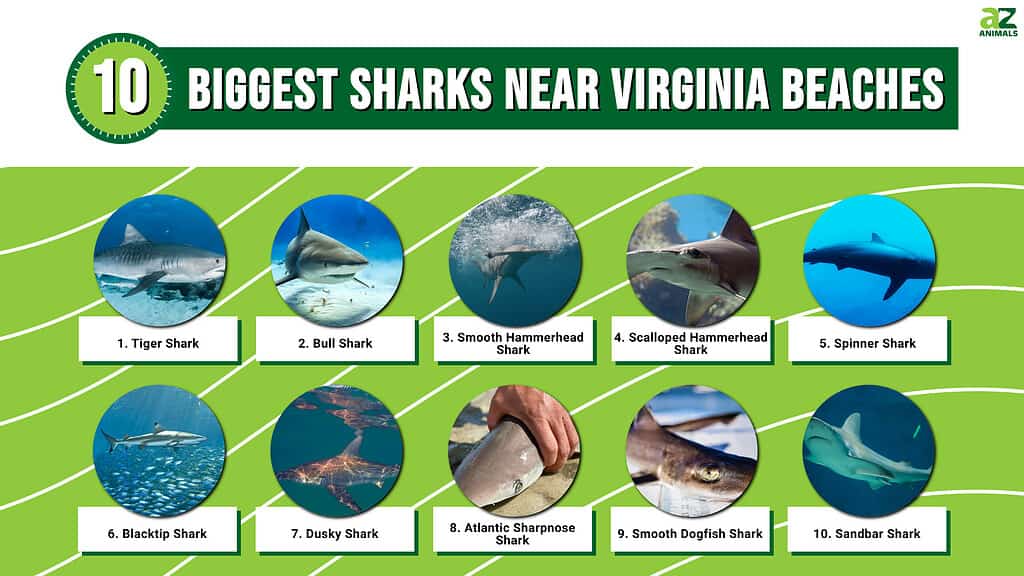
Ready to learn more about the biggest sharks near Virginia beaches? Let’s dive in!
10. Sandbar Shark
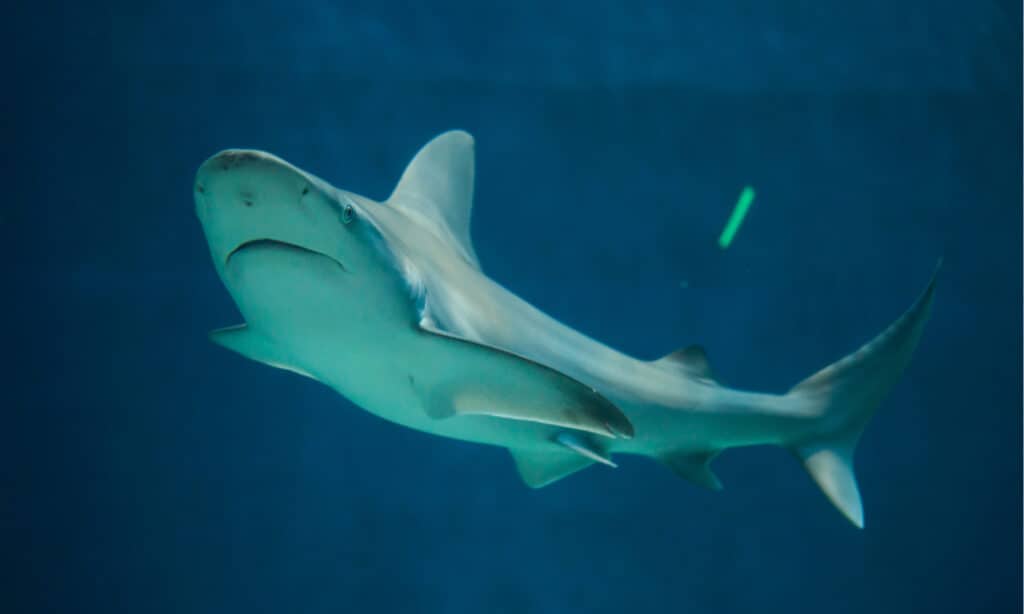
Sandbar sharks are named for their presence in shallow waters.
©Vladimir Wrangel/Shutterstock.com
The sandbar shark has many names, including brown shark or thickskin shark. It’s not only one of the biggest sharks near Virginia beaches but also one of the largest coastal sharks in the world.
Females are larger than males, as with most sharks, and they can reach an adult length of 8.2 feet. Not sure just how impressive that is? If you were to stand an adult female sandbar shark on her tailfin so she stood upright, she would be taller than certain types of elephants!
Sandbar sharks are typically found in shallow waters. This includes locations such as bays, harbors, or estuaries. However, they may also occasionally swim out to deeper water, sometimes visiting water over 600 feet deep. Although you can find sandbar sharks as far south as Brazil, the Chesapeake Bay is one the most common areas to find juvenile sandbar sharks.
Although sandbar sharks are similar in size and appearance to some of the most dangerous sharks in the ocean, they’re fairly harmless themselves. In fact, they’re considered one of the safest sharks to swim with. However, sandbar sharks are still wild animals with the potential to cause harm. Though attacks are few and far between, there was an attack recorded in 2021 that resulted in stitches.
The sandbar shark is related to several other of the biggest sharks near Virginia beaches, including the dusky shark and the bull shark.
9. Smooth Dogfish
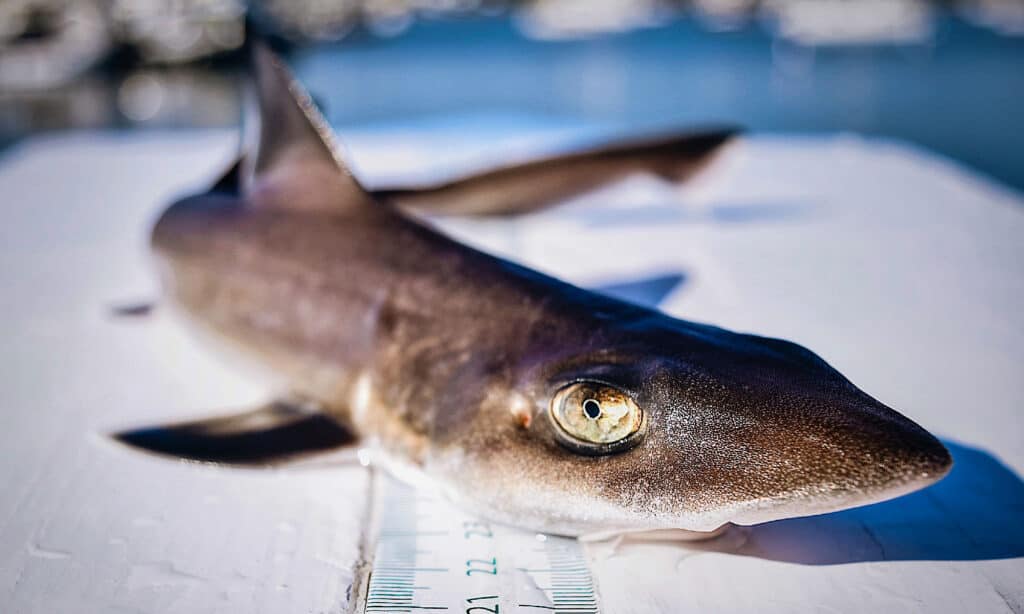
The smooth dogfish has many different names.
©Rafeed Hussain/Shutterstock.com
If you’re not familiar with the smooth dogfish shark, then you may know it by another name. These large sharks go by many names, including Atlantic smooth dogfish, dusky smooth-hound, grayish, nurse shark, smooth dog, or smooth-hound. No matter their name, however, the smooth dogfish is one of the biggest sharks near Virginia beaches.
On average, the smooth dogfish shark can reach lengths of about 5 feet. While this may seem small, it’s important to remember that coastal sharks have different resources than deep-water sharks. This means that sharks found in shallower waters, like those near Virginia beaches, won’t grow to be as large as, say, a great white shark.
These shallow waters also play a role in the smooth dogfish’s diet – and, as a result, their teeth. One of the unique characteristics of the smooth dogfish is its row of blunt teeth. The smooth dogfish’s diet is mainly made up of crustaceans like crabs. As a result, their unique teeth allow them to crush and grind their food, which is necessary when a strong shell is keeping them away from their next meal!
The smooth dogfish water tends to favor warmer waters. This means they’re common along the east coast of the United States as well as in the Gulf of Mexico. However, some smooth dogfish sharks can be found in the waters off of Argentina in South America.
8. Atlantic Sharpnose Shark
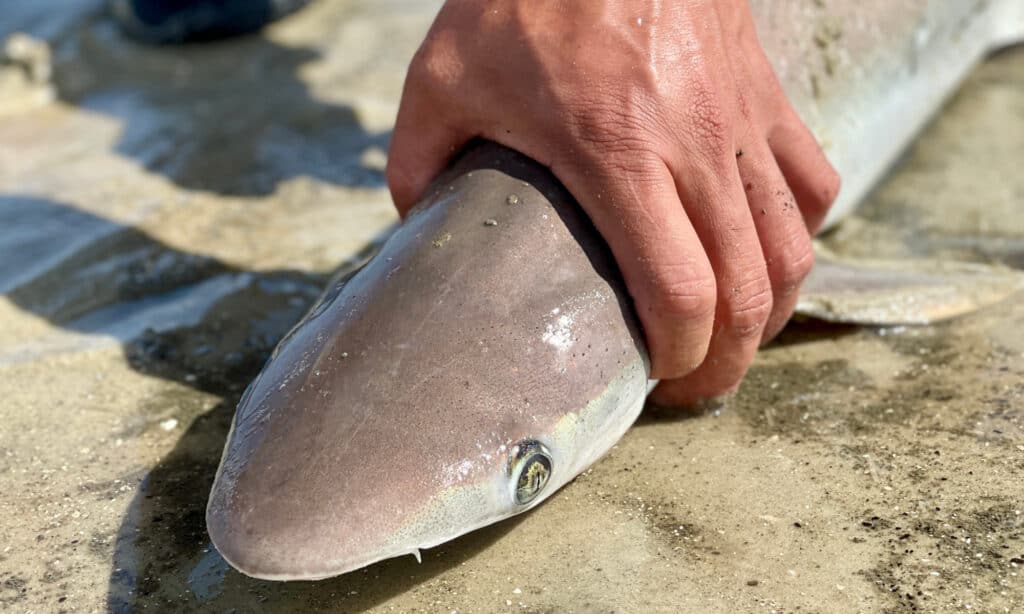
The Atlantic sharpnose shark is a common shark in the United States.
©Finley Del/Shutterstock.com
Like the smooth dogfish, the Atlantic sharpnose shark is relatively small for a shark. However, with lengths of up to 4 feet, it is still one of the biggest sharks near Virginia beaches. They get their name from their sharp nose, and you can find them both in the Atlantic and the Gulf of Mexico.
Surprisingly, the Atlantic sharpnose shark is actually a common fishing target. The National Oceanic And Atmospheric Administration actually consider it to be a sustainable wild-caught food option because of how they’re managed. As of now, the Atlantic sharpnose shark populations in both the Atlantic and in the Gulf of Mexico are thriving and well above target numbers. However, regulations help ensure that we’ll be able to enjoy the Atlantic sharpnose’s presence for many more years.
The Atlantic sharpnose shark has a diet fairly average for coastal sharks. They eat small fish as well as eels, shrimp, crabs, and mollusks.
7. Dusky Shark
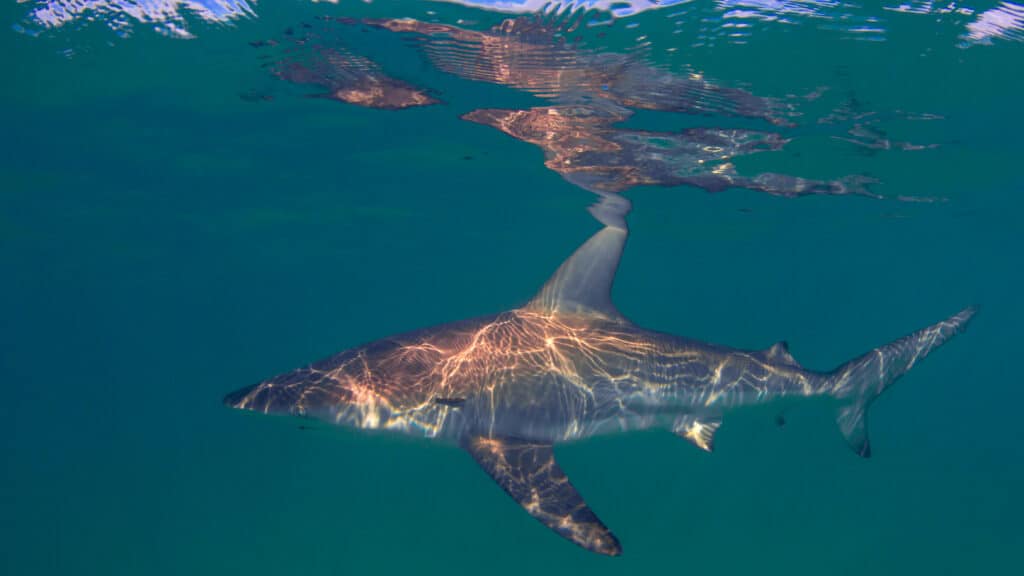
The dusty shark can weigh nearly half a ton!
©Rich Carey/Shutterstock.com
The dusky shark is a species of requiem shark, just like the sandbar shark. However, they’re much larger. At their largest, the dusky shark can reach lengths of up to 14 feet. That’s the same length as the average car. They can also weigh nearly 800 pounds. This makes it one of the largest sharks in its genus, Carcharhinus.
In the past, the dusky shark has been considered endangered. This is because they have relatively slow reproduction periods, as well as slow maturation rates. However, they’re also popular targets of fishing for their fins and oils, which have threatened this species in the past.
Overall, the dusky shark doesn’t pose much of a threat to humans. However, there have been a few recorded attacks, and their large size means you’ll need to be careful around them.
Dusky sharks can be found nearly worldwide, which is a first for the sharks on this list so far. While they’re most common on the Atlantic shores of North and South America, dusky sharks can also be found in Africa, Australia, and certain islands in Asia. Although they are one of the biggest sharks near Virginia beaches, their large size actually comes from their ability to live in the intermediate waters between the coast and the deep ocean.
The name “dusky shark” comes from their dark coloration. Other names for this species that you might recognize include bay shark, brown common gray shark, brown dusky shark, brown shark, dusky ground shark, shovelnose, and slender whaler shark.
6. Blacktip Shark
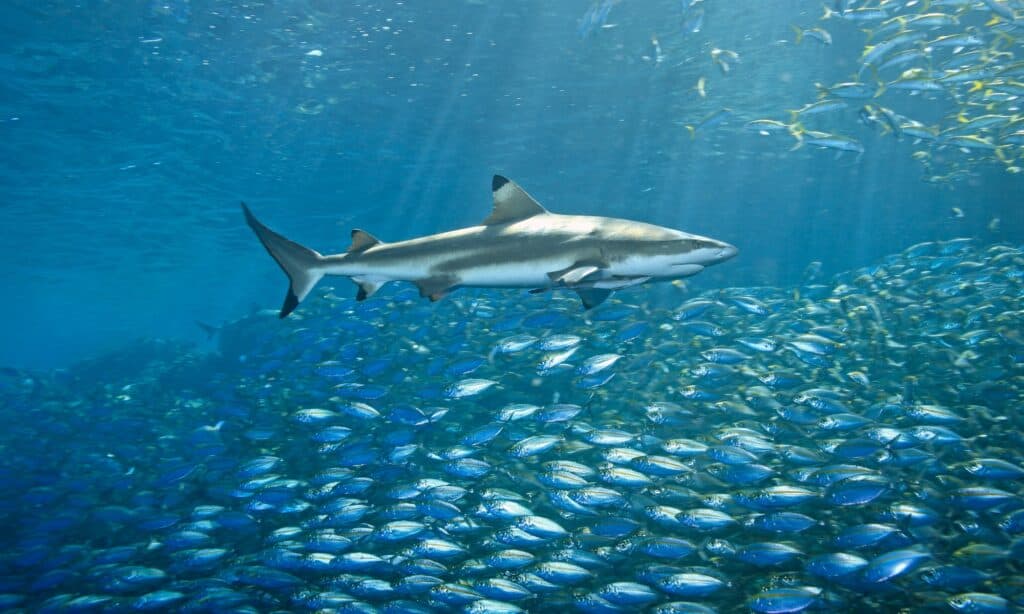
These sharks are streamlined hunters that patrol the edges of coral reefs.
©iStock.com/cbpix
The blacktip shark is probably one of the easiest sharks to identify. This is because their name comes from the tell-tale black tip that you can find on all their fins. The blacktip shark is another species of requiem shark, making it loosely related to the sandbar shark and the dusky shark.
Like the sandbar shark, the blacktip shark is considerably smaller than its deep-water cousin, the dusky shark. As an adult, the blacktip shark will typically grow to be around 9 feet in length.
Blacktip sharks are actually considered fairly aggressive sharks. Although they tend to be wary around humans and would much rather avoid confrontation, the same cannot be said when food is present. There have been several recorded attacks. This doesn’t make the blacktip shark “bad”, however – it just means that you may not want to go swimming with one the way you would other sharks.
One of the most interesting facts about the blacktip shark is that it’s one of few shark species capable of what is known as asexual reproduction. This means that, without the presence of a male shark, a female can still create offspring. This is through an ability known as automatic parthenogenesis, or self-fertilization.
5. Spinner Shark

Spinner sharks are known for jumping out of the water.
©Bram Nieuwenhuis/Shutterstock.com
The spinner shark is actually a deep-water shark, living in waters as deep as 330 feet. However, it prefers to visit shallow coastal waters, which can make it an occasional visitor at Virginia beaches. It has an appearance similar to that of the blacktip shark.
Spinner sharks are rare sights in Virginia, but they may occasionally show up. This is because they tend to favor warm climates, such as Australia, South America, and Africa. However, there are some that live along the southeast coast of the United States, which includes parts of Virginia. Spinner sharks are most common in this area when it is time for pups, as baby spinner sharks are usually raised in shallow nursery waters like bays.
Like other types of sharks, the spinner shark has many different names. Some of the other common names for this species include black-tipped shark, great blacktip shark, inkytail shark, large blacktip shark, long-nose grey shark, longnose grey whaler, and smoothfang shark. However, the scientific name for the spinner shark is Carcharhinus brevipinna, making them another species of requiem shark.
The spinner shark is considered a threatened species, with an International Union for Conservation of Nature statute of vulnerable. This is due to overfishing for their livers and fins.
4. Scalloped Hammerhead

The scalloped hammerhead is one of the smaller hammerhead species – but still one of the biggest sharks near Virginia beaches.
©Ian Scott/Shutterstock.com
While the scalloped hammerhead shark is one of the biggest sharks near Virginia beaches, it’s actually one of the smallest hammerhead sharks. Growing to a length of around 8.2 feet, the scalloped hammerhead is smaller than the great hammerhead shark and the smooth hammerhead shark. However, some specimens of scalloped hammerhead sharks have reached lengths over 10 feet!
During most of the year, you probably won’t find a scalloped hammerhead shark near the coastlines in Virginia. In fact, you probably won’t find them near any coastlines regularly, as they’re deep-water sharks that thrive in the open ocean. However, they will move inland to take advantage of the shallow waters when it comes to breeding seasoning. Having their pups here instead of in the deeper waters provides the young sharks with both protection and food – both of which they need to thrive. This is because scalloped hammerhead sharks have high metabolic rates, which means that they need more food than some other types of sharks may need.
During the rest of the year, scalloped hammerhead sharks can be found in most areas of the world. However, they are most common in the Pacific ocean. The scalloped hammerhead is also known as the bronze, kinky-headed, or southern hammerhead.
3. Smooth Hammerhead Shark
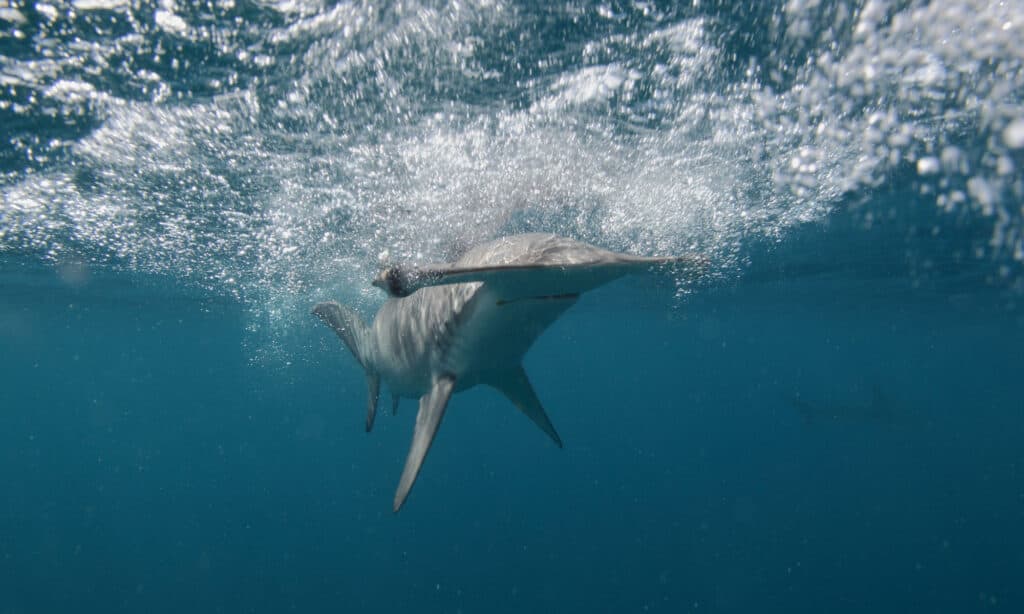
Smooth hammerhead sharks like to steal bait!
©Alessandro De Maddalena/Shutterstock.com
Just like with the scalloped hammerhead shark, you can find the smooth hammerhead shark in Virginia as well. The second-largest type of hammerhead shark, the smooth hammerhead can grow to be up to 16 feet long – twice that of the scalloped hammerhead! However, despite its large size, the smooth hammerhead shark is actually a more common coastal find than the scalloped hammerhead shark.
While most smooth hammerhead sharks are happy eating small fish and invertebrates, some of the largest individuals have been known to eat other sharks and rays. Their large size can make them dangerous for humans, with some attacks being reported. But like all other sharks, they prefer to stay away from people. However, they are known to swim near piers and fishing spots to steal catches and baits from those fishing.
Like their smaller relative, the smooth hammerhead shark is listed as a vulnerable species. Alongside other sharks in similar predicaments, this is due to overfishing for their fins and livers. However, many government agencies in countries where hammerhead shark species are common have been coming together and looking for solutions to save these giant sharks.
2. Bull Shark
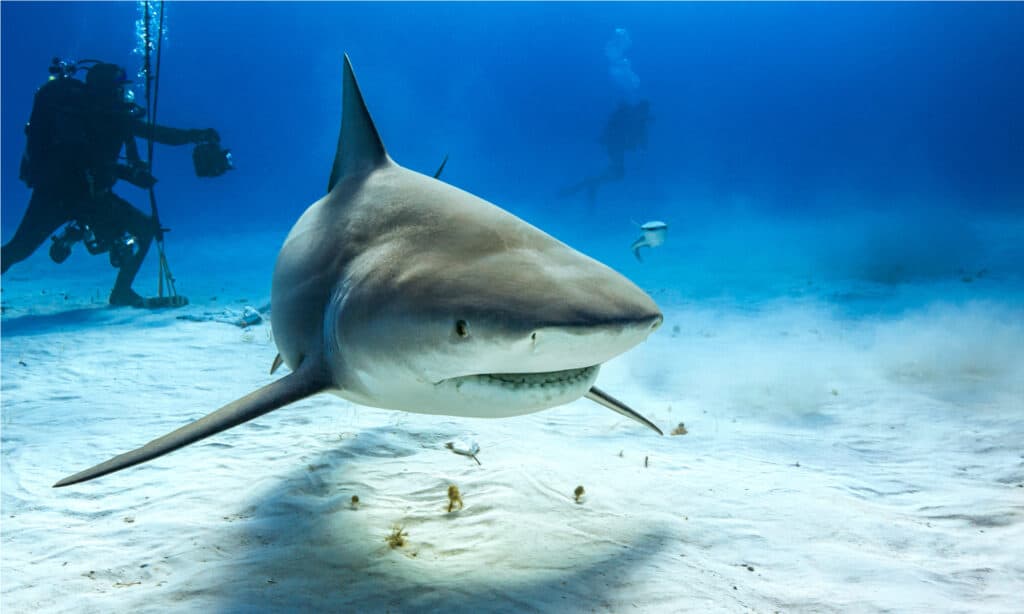
A trait uncommon to other sharks, bull sharks can live in salt or freshwater!
©Carlos Grillo/Shutterstock.com
Bull sharks aren’t a common sight in Virginia. Instead, they tend to favor the open ocean where they can thrive in deep waters. However, they are still an occasional visitor to the coastline, making them one of the biggest sharks near Virginia beaches. Some of their other names reflect their ability to live in multiple areas of the world, such as Zambezi shark and Lake Nicaragua shark.
However, it may be a good thing that bull sharks aren’t a common sight at most Virginia beaches. This is because they are known for their aggressive behaviors. In fact, a majority of bites that occur in coastal areas – to humans and other species! Despite this, however, bull sharks aren’t the largest shark on this list. Typically, they only reach maximum lengths of around 11 feet. However, there has been a single female individual that was recorded at exactly 13 feet long!
One of the most interesting facts about the bull shark is that, while they’re not river sharks, they can live in freshwater. In fact, some have even been known to travel up the Mississippi River! This is due to a process known as osmoregulation. With osmoregulation, bull sharks and other creatures that are considered osmoregulators are able to balance their internal organs with the salinity or salt content in their outside environment. This helps the bull shark to thrive in both the salty ocean and freshwater.
1. Tiger Shark
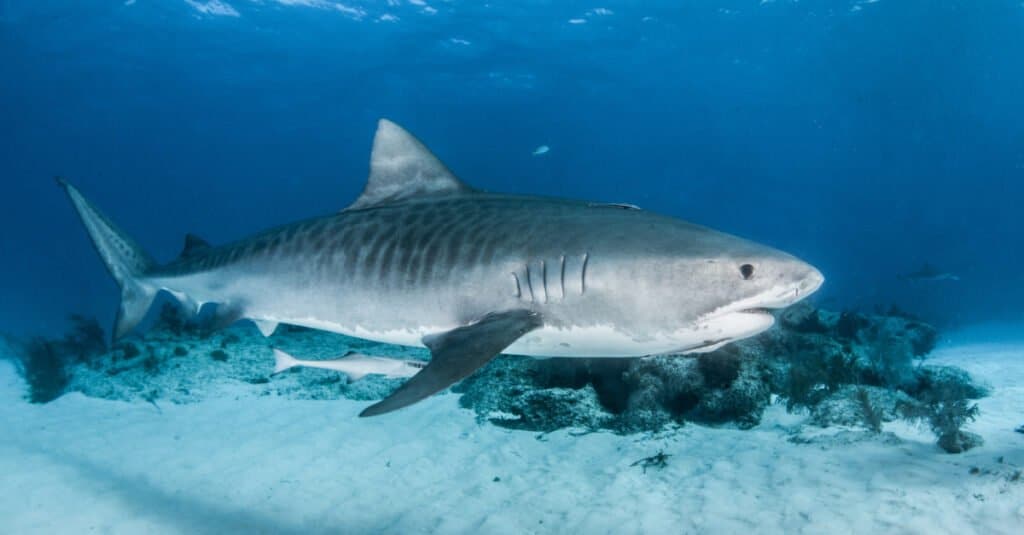
The
tiger
shark gets its name from the vertical lines that run along the side of its body.
©iStock.com/Divepic
Like the bull shark, the tiger shark isn’t a common sight in Virginia, especially in coastal waters. However, it may still occasionally travel into shallower waters. This isn’t the only thing that have in common, however. The tiger shark is also known to be an aggressive shark that has attacked unprovoked before. Like with other sharks, however, this is due to instincts and doesn’t make them a bad animal. Attacks are still fairly rare, and tiger sharks are an essential part of the ecosystem.
The tiger shark is one of the biggest sharks near Virginia beaches. In fact, they’re one of the biggest sharks in the entire world! Adult tiger sharks have been known to reach length of over 14 feet. That’s the same size as a canoe.
This large size allows for them to have what is considered the most diverse diet out of all other sharks. Tiger sharks have been known to eat everything from seals to dolphins to birds and even other sharks. They’re also known as garbage eaters due to the prevalence of trash often found in their bellies.
The photo featured at the top of this post is © HakBak/Shutterstock.com
Thank you for reading! Have some feedback for us? Contact the AZ Animals editorial team.






